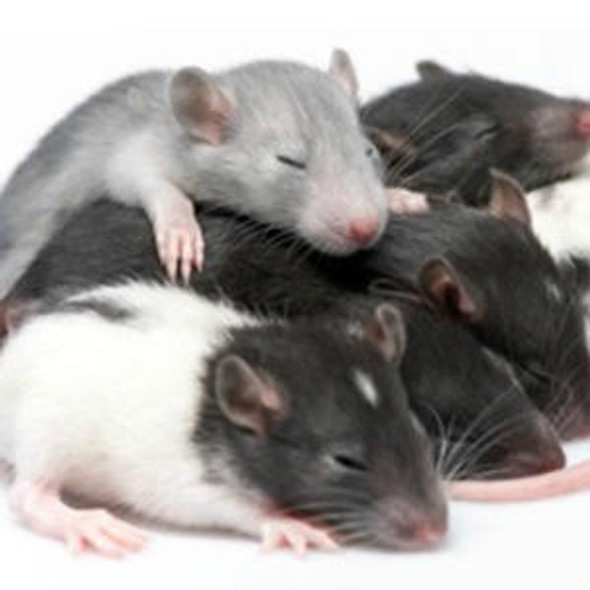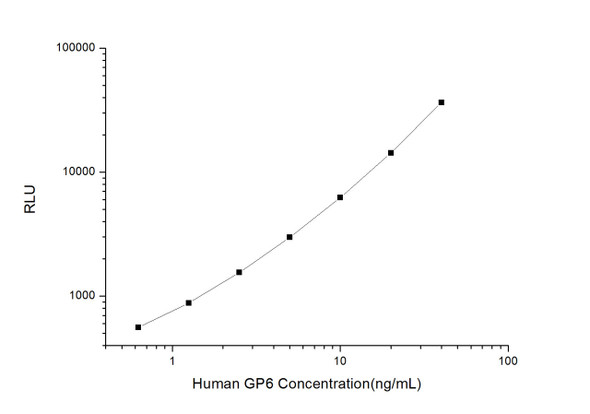Human Cardiovascular ELISA Kits
Human GP5 (Glycoprotein V, Platelet) CLIA Kit (HUES01078)
- SKU:
- HUES01078
- Product Type:
- ELISA Kit
- ELISA Type:
- CLIA Kit
- Size:
- 96 Assays
- Sensitivity:
- 0.19ng/mL
- Range:
- 0.31-20ng/mL
- ELISA Type:
- Sandwich
- Reactivity:
- Human
- Sample Type:
- Serum, plasma and other biological fluids
- Research Area:
- Cardiovascular
Description
| Assay type: | Sandwich |
| Format: | 96T |
| Assay time: | 4.5h |
| Reactivity: | Human |
| Detection method: | Chemiluminescence |
| Detection range: | 0.31-20 ng/mL |
| Sensitivity: | 0.19 ng/mL |
| Sample volume: | 100µL |
| Sample type: | Serum, plasma and other biological fluids |
| Repeatability: | CV < 15% |
| Specificity: | This kit recognizes Human GP5 in samples. No significant cross-reactivity or interference between Human GP5 and analogues was observed. |
This kit uses Sandwich-CLIA as the method. The micro CLIA plate provided in this kit has been pre-coated with an antibody specific to Human GP5. Standards or samples are added to the appropriate micro CLIA plate wells and combined with the specific antibody. Then a biotinylated detection antibody specific for Human GP5 and Avidin-Horseradish Peroxidase (HRP) conjugate are added to each micro plate well successively and incubated. Free components are washed away. The substrate solution is added to each well. Only those wells that contain Human GP5, biotinylated detection antibody and Avidin-HRP conjugate will appear fluorescence. The Relative light unit (RLU) value is measured spectrophotometrically by the Chemiluminescence immunoassay analyzer. The RLU value is positively associated with the concentration of Human GP5. The concentration of Human GP5 in the samples can be calculated by comparing the RLU of the samples to the standard curve.
| UniProt Protein Function: | GPV: The GPIb-V-IX complex functions as the vWF receptor and mediates vWF-dependent platelet adhesion to blood vessels. The adhesion of platelets to injured vascular surfaces in the arterial circulation is a critical initiating event in hemostasis. |
| UniProt Protein Details: | Protein type:Membrane protein, integral; Cell adhesion Chromosomal Location of Human Ortholog: 3q29 Cellular Component: integral to plasma membrane; plasma membrane Molecular Function:collagen binding; protein binding Biological Process: axonogenesis; blood coagulation; blood coagulation, intrinsic pathway; cell adhesion; cell-matrix adhesion; platelet activation |
| NCBI Summary: | Human platelet glycoprotein V (GP5) is a part of the Ib-V-IX system of surface glycoproteins that constitute the receptor for von Willebrand factor (VWF; MIM 613160) and mediate the adhesion of platelets to injured vascular surfaces in the arterial circulation, a critical initiating event in hemostasis. The main portion of the receptor is a heterodimer composed of 2 polypeptide chains, an alpha chain (GP1BA; MIM 606672) and a beta chain (GP1BB; MIM 138720), that are linked by disulfide bonds. The complete receptor complex includes noncovalent association of the alpha and beta subunits with platelet glycoprotein IX (GP9; MIM 173515) and GP5. Mutations in GP1BA, GP1BB, and GP9 have been shown to cause Bernard-Soulier syndrome (MIM 231200), a bleeding disorder (review by Lopez et al. , 1998 [PubMed 9616133]). [supplied by OMIM, Nov 2010] |
| UniProt Code: | P40197 |
| NCBI GenInfo Identifier: | 4758460 |
| NCBI Gene ID: | 2814 |
| NCBI Accession: | NP_004479. 1 |
| UniProt Secondary Accession: | P40197,D1MER9, |
| UniProt Related Accession: | P40197 |
| Molecular Weight: | 60,959 Da |
| NCBI Full Name: | platelet glycoprotein V |
| NCBI Synonym Full Names: | glycoprotein V platelet |
| NCBI Official Symbol: | GP5 |
| NCBI Official Synonym Symbols: | GPV; CD42d |
| NCBI Protein Information: | platelet glycoprotein V |
| UniProt Protein Name: | Platelet glycoprotein V |
| UniProt Synonym Protein Names: | Glycoprotein 5; CD_antigen: CD42d |
| Protein Family: | Protein |
| UniProt Gene Name: | GP5 |
| UniProt Entry Name: | GPV_HUMAN |
As the RLU values of the standard curve may vary according to the conditions of the actual assay performance (e. g. operator, pipetting technique, washing technique or temperature effects), the operator should establish a standard curve for each test. Typical standard curve and data is provided below for reference only.
| Concentration (ng/mL) | RLU | Average | Corrected |
| 20 | 33642 34322 | 33982 | 33950 |
| 10 | 11247 13693 | 12470 | 12438 |
| 5 | 5540 4960 | 5250 | 5218 |
| 2.5 | 2359 2689 | 2524 | 2492 |
| 1.25 | 1491 1275 | 1383 | 1351 |
| 0.63 | 881 853 | 867 | 835 |
| 0.31 | 580 666 | 623 | 591 |
| 0 | 31 33 | 32 | -- |
Precision
Intra-assay Precision (Precision within an assay): 3 samples with low, mid range and high level Human GP5 were tested 20 times on one plate, respectively.
Inter-assay Precision (Precision between assays): 3 samples with low, mid range and high level Human GP5 were tested on 3 different plates, 20 replicates in each plate.
| Intra-assay Precision | Inter-assay Precision | |||||
| Sample | 1 | 2 | 3 | 1 | 2 | 3 |
| n | 20 | 20 | 20 | 20 | 20 | 20 |
| Mean (ng/mL) | 0.98 | 1.68 | 9.11 | 1.07 | 1.79 | 8.62 |
| Standard deviation | 0.08 | 0.15 | 0.82 | 0.13 | 0.18 | 0.66 |
| C V (%) | 8.16 | 8.93 | 9.00 | 12.15 | 10.06 | 7.66 |
Recovery
The recovery of Human GP5 spiked at three different levels in samples throughout the range of the assay was evaluated in various matrices.
| Sample Type | Range (%) | Average Recovery (%) |
| Serum (n=5) | 83-95 | 90 |
| EDTA plasma (n=5) | 96-110 | 104 |
| Cell culture media (n=5) | 85-98 | 90 |
Linearity
Samples were spiked with high concentrations of Human GP5 and diluted with Reference Standard & Sample Diluent to produce samples with values within the range of the assay.
| Serum (n=5) | EDTA plasma (n=5) | Cell culture media (n=5) | ||
| 1:2 | Range (%) | 103-116 | 87-100 | 101-116 |
| Average (%) | 109 | 94 | 107 | |
| 1:4 | Range (%) | 92-102 | 101-119 | 91-106 |
| Average (%) | 97 | 109 | 97 | |
| 1:8 | Range (%) | 94-111 | 96-112 | 86-100 |
| Average (%) | 102 | 104 | 91 | |
| 1:16 | Range (%) | 84-96 | 87-99 | 96-110 |
| Average (%) | 91 | 92 | 102 |
An unopened kit can be stored at 4°C for 1 month. If the kit is not used within 1 month, store the items separately according to the following conditions once the kit is received.
| Item | Specifications | Storage |
| Micro CLIA Plate(Dismountable) | 8 wells ×12 strips | -20°C, 6 months |
| Reference Standard | 2 vials | |
| Concentrated Biotinylated Detection Ab (100×) | 1 vial, 120 µL | |
| Concentrated HRP Conjugate (100×) | 1 vial, 120 µL | -20°C(shading light), 6 months |
| Reference Standard & Sample Diluent | 1 vial, 20 mL | 4°C, 6 months |
| Biotinylated Detection Ab Diluent | 1 vial, 14 mL | |
| HRP Conjugate Diluent | 1 vial, 14 mL | |
| Concentrated Wash Buffer (25×) | 1 vial, 30 mL | |
| Substrate Reagent A | 1 vial, 5 mL | 4°C (shading light) |
| Substrate Reagent B | 1 vial, 5 mL | 4°C (shading light) |
| Plate Sealer | 5 pieces | |
| Product Description | 1 copy | |
| Certificate of Analysis | 1 copy |
- Set standard, test sample and control (zero) wells on the pre-coated plate and record theirpositions. It is recommended to measure each standard and sample in duplicate. Note: addall solutions to the bottom of the plate wells while avoiding contact with the well walls. Ensuresolutions do not foam when adding to the wells.
- Aliquot 100 µL of standard solutions into the standard wells.
- Add 100 µL of Sample / Standard dilution buffer into the control (zero) well.
- Add 100 µL of properly diluted sample (serum, plasma, tissue homogenates and otherbiological fluids. ) into test sample wells.
- Cover the plate with the sealer provided in the kit and incubate for 90 min at 37 °C.
- Aspirate the liquid from each well, do not wash. Immediately add 100 µL of BiotinylatedDetection Ab working solution to each well. Cover the plate with a plate seal and gently mix. Incubate for 1 hour at 37 °C.
- Aspirate or decant the solution from the plate and add 350 µL of wash buffer to each welland incubate for 1-2 minutes at room temperature. Aspirate the solution from each well andclap the plate on absorbent filter paper to dry. Repeat this process 3 times. Note: a microplatewasher can be used in this step and other wash steps.
- Add 100 µL of HRP Conjugate working solution to each well. Cover with a plate seal andincubate for 30 min at 37 °C.
- Aspirate or decant the solution from each well. Repeat the wash process for five times asconducted in step 7.
- Add 100 µL of Substrate mixture solution to each well. Cover with a new plate seal andincubate for no more than 5 min at 37 °C. Protect the plate from light.
- Determine the RLU value of each well immediately.






